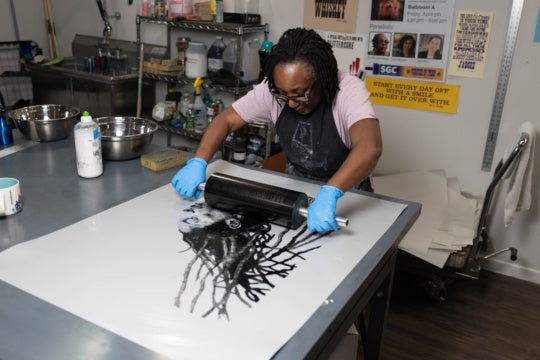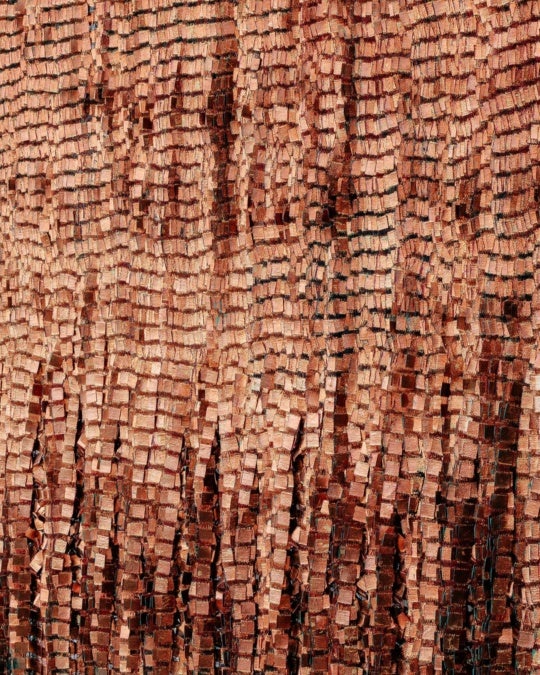
Beautifully adorned punching bags hang from the ceiling in Jeffrey Gibson’s solo exhibition “A Kind of Confession” at the SCAD Museum of Art in Savannah through October 23. Each pendulous bag, decorated with shiny ornaments, embroidered beaded text, and colorful hanging threads, emblematizes Gibson’s metaphorical battle against the marginalization of Native Americans and the commercial co-opting of their culture in the U.S., a battle that also plays out in wall hangings, paintings and sculptures that similarly combine elements of Native and popular American culture.
For Gibson, the term “identity” was problematic. His artistic sensibility was not shaped by growing up in a traditional Native American community. Born half Cherokee, half Choctaw to parents who were raised on reservations, he had an itinerant childhood in a military family. Later, his education at the Royal College of Art in London and the Art Institute of Chicago helped Gibson formulate his Native American identity as a lived, evolving experience rather than as a relic, immortalized in museum artifacts.

Gibson’s assemblages embody his vision of a continually expanding vocabulary that combines traditional Native American imagery with contemporary forms. The genesis of his punching bags came in 2005 during a phase of deep introspection and turmoil about questions of race, class, and marginalization. At the time, punching the bags released his anger, and these objects would become symbolic of his highly personal journey. A trip that same year to visit Native American artists in Oklahoma, Oregon, and South Dakota brought Gibson closer to his community. Not only did their traditional attire resonate with him, but his sense of kinship also compelled him to commission pieces of beaded embroidery and decorative handicrafts that they made regularly for powwows held all over the country. By 2010, these components would evolve into pendulous sculptures of boxing bags decorated with colorful glass beads, metal jingles, yarn, steel studs, and repurposed blankets, recalling powwow regalia and the costumes worn by dancers.
Works such as Ain’t Got No, I Got a Life and From a Whisper to a Scream epitomize Gibson’s aesthetic that combines the powwow dancers’ exquisite handicrafts with the rugged, masculine punching bags. But most importantly, these hanging sculptures give voice to Gibson’s heritage. Phrases such as “Ain’t Got No, I Got a Life,” taken from lyrics by Nina Simone, are emblazoned on his beaded punching bags and evoke the resilience of Native Americans in the face of hardship and oppression. Akin to trophies, the punching bags convey defiance as they remind viewers of the historical plight of Native Americans, even as their cultural traditions and crafts are co-opted by consumer culture.

Gibson’s wall hangings resemble Choctaw blankets that are often displayed on the walls in private homes or museums. No different than the abstract three-dimensional shapes in his paintings that blur the distinction between painting and textile, his beaded wall hangings resemble knotted hand-woven textiles. Reminiscent of carnivalesque decorations from the Caribbean Islands, the same materials used to decorate the punching bags appear on the wall hangings arranged in geometric patterns and designs from Native American blankets. By replacing traditional materials such as moose hair, dyed horsehair, porcupine quills, and earth paint with modern ornamental materials produced in bulk all over Asia, Gibson marks the trajectory of trade and the evolution of Native American culture that began in the 1700s.
Inspiring texts on his wall hangings, such as The Only Way Out is Through and his reference to the song Burn Baby Burn, which inspires listeners to look inward, transform Gibson into a community elder whose sage advice and strength comes from a place of experience and great comfort with his culture. The grandeur of a community elder can also be seen in the freestanding work All for One, One for All. Three branches arranged to resemble a tepee make up the skeletal form of a high priest fitted with a round ceramic sculpture for a head. A colorful striped cloak decorated with metal jingles draped over the branches gives the figure majesty and suggests prominence. Although somewhat ominous-looking, the figure seems appropriately symbolic of Gibson’s repositioning of Native American culture from a relic of the past to a living presence.
“A Kind of Confession” is on view at the SCAD Museum of Art in Savannah through October 23.
Bansie Vasvani is an art critic based in New York City.




